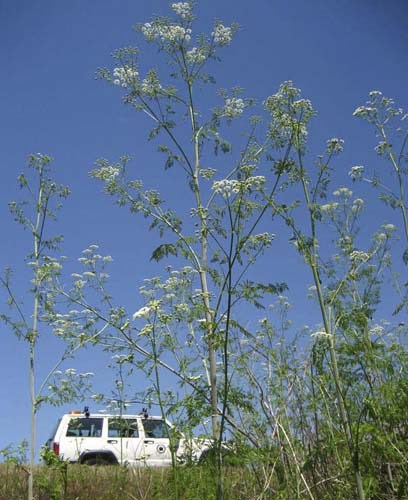– Contributed by San Juan County Noxious Weed Control Program staff
In 2009, 17 poison hemlock exposures were recorded by the Washington Poison Center. In 2010, a Bellingham man was hospitalized after having eaten what looked like a baby carrot growing in his garden. The same year a Tacoma woman died after accidently ingesting this deadly plant. Poison hemlock is a potently toxic member of the parsley family and when young, is easily confused with other more benign members of this family, such as Queen Anne’s lace, wild chervil or domestic carrot. It may be distinguished chiefly by its lacey, fern-like leaves, its height (up ten feet), its smooth purple-blotched stalk and unpleasant odor. Often called “fool’s parsley,” only small amounts can sicken or kill both humans and animals. Poison hemlock can also cause birth defects when consumed by pregnant livestock. In ancient Greece, hemlock was a classic executioner’s potion and used to assassinate Socrates. All parts of the plant are poisonous. Livestock normally avoid fresh plants, but when dried they lose their characteristic “mousey” odor,” becoming more palatable, but remaining toxic.
Poison hemlock is a Class B designate noxious weed in San Juan County, and control is required. Although commonly seen along roadsides, and in open fields on the mainland, it is only sparsely scattered throughout the islands, with Lopez and San Juan Islands having small patches, and with less on Orcas. In San Juan County, it has been found in gardens, pastures, gravel pits and in other disturbed areas. It thrives in cool, moist climates, making it well adapted to the climate of the San Juan Islands. Originally from Eurasia and introduced to North America as an ornamental garden plant, it has become, unfortunately, a common contaminant in gravel and soil.
Wear protective clothing (including a long sleeved shirt, gloves and eye protection) when working with poison hemlock. In the winter and early spring, rosettes and bolting plants can be dug out. Mature plants can be cut or mowed when they are in flower but before all flowers completely open. If cut earlier, the plants will regrow. Remove all cut plants from gardens, pastures, play areas, since cut plants remain poisonous and chemicals leaching from the decomposing plants suppress the regrowth of other vegetation. Do not burn the remains. Applying a layer of cardboard will suppress poison hemlock and its seed bank, which should only be viable for about three years. For chemical control, a glyphosate product can be applied on individual rosettes. If you choose to use an herbicide, follow label instructions. The label is the law. In some areas of the northwest, the hemlock moth (Agonopterix alstroemeriana) has been used successfully to defoliate large stands, but this insect has not been particularly effective in the San Juan Islands. To help prevent poison hemlock spread into the islands, ask for noxious weed free soil and gravel. For more info, or to schedule a free site inspection for noxious weeds, call either Rich Lee or Judy Jackson at the County Noxious Weed Control program office at 376-3499.



